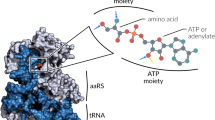Summary
The values of kcat/Km are strongly correlated with chain length for the reactions of E. coli tyrosine aminotransferase, but are nearly independent of this variable for aspartate aminotransferase. Both enzymes exhibit nearly equal reactivity with dicarboxylic acid substrates. Six key amino acid differences were identified that were found to be responsible for 80% of the specificity difference. It is postulated that a major role for Arg292 in aspartate transaminase is to exclude nonspecific substrates by keeping the enzyme in an open inactive form. The free energy to close the enzyme into its active conformation derives from association with specific ligands.
Access this chapter
Tax calculation will be finalised at checkout
Purchases are for personal use only
Preview
Unable to display preview. Download preview PDF.
Similar content being viewed by others
References
Bradley, M., Biicheler, U. S., and Walsh, C. T. (1991) Redox enzyme engineering: conversion of human glutathione reductase into a trypanothione reductase. Biochemistry 30: 6124–6127.
Dunn, C. R., Wilks, H. M., Halsall, D. J., Atkinson, T., Clarke, A. R., Muirhead, H., and Holbrook, J. J. (1991) Design and synthesis of new enzymes based on the lactate dehydrogenase framework. Phil. Trans. R. Soc. Lond. B 332: 177–184.
Estell, D. A., Graycar, T. P., Miller, J. V., Powers, D. B., Burnier, J. P., Ng, P. G., and Wells, J. A. (1986) Probing steric and hydrophobic effects on enzyme-substrate interactions by protein engineering. Science 233: 659–663.
Hayashi, H., Inoue, K., Nagata., T., Kuramitsu, S., and Kagamiyama, H. (1993) Escherichia coli aromatic amino acid aminotransferase: characterization and comparison with aspartate aminotransferase. Biochemistry 32: 12229–12239.
Hedstrom,.L., Szilagyi, L., Rutter, W. J. (1992) Converting trypsin to chymotrypsin: the role of surface loops. Science 255: 1249–1253.
Henderson, G. B., Murgolo, N. J., Kuriyan, J., Osapay, K., Kominos, D., Berry, A., Scrutton, N. S., Hinchliffe, N. W., Perham, R. N., and Cerami, A. (1991) Engineering the substrate specificity of glutathione reductase toward that of trypanothione reduction. Proc. Natl. Acad. Sci. 88: 8769–8773.
Julin, D. A., and Kirsch, J. F. (1989) Kinetic isotope effect studies on aspartate aminotransferase: evidence for a concerted 1,3 prototropic shift mechanism for the cytoplasmic isozyme and L-aspartate and dichotomy in mechanism. Biochemistry 28: 3825–3833.
Kiick, D. M. and Cook, P. F. (1983) pH studies toward the elucidation of the auxiliary catalyst for pig heart aspartate aminotransferase. Biochemistry 22: 375–382.
Kirsch, J. F., Eichele, G., Ford, G. C., Vincent, M. G., Jansonius, J. N., Gehring, H., and Christen, P. (1984) Mechanism of action of aspartate aminotransferase proposed on the basis of its spatial structure. J. Malec. Biol. 174: 497–525.
Powell, J. T. and Morrison, J. F. (1978) The purification and properties of the aspartate aminotransferase and aromatic-amino-acid aminotransferase from Escherichia coli. Eur J. Biochem. 87: 391–400.
Malashkevich, V. N., Toney, M. D., and Jansonius, J. N. (1993) Crystal structures of true enzymatic reaction intermediates: aspartate and glutamate ketimines in aspartate aminotransferase. Biochemistry 32: 13451–13462.
Velick, S. G. and Vavra, J. (1962) A kinetic and equilibrium analysis of the glutamic oxaloacetate transaminase mechanism. J. Biol. Chem. 237: 2109–2122.
Wells, J. A., Powers, D. B., Bott, R. R., Graycar, T. P., and Estell, D. A. (1987) Designing substrate specificity by protein engineering of electrostatic interactions. Proc. Natl. Acad. Sci. U. S. A. 84: 1219–1223.
Author information
Authors and Affiliations
Editor information
Editors and Affiliations
Rights and permissions
Copyright information
© 1994 Birkhäuser Verlag Basel/Switzerland
About this paper
Cite this paper
Kirsch, J.F., Onuffer, J.J. (1994). Redesign of aspartate aminotransferase specificity to that of tyrosine aminotransferase. In: Marino, G., Sannia, G., Bossa, F. (eds) Biochemistry of Vitamin B6 and PQQ. Advances in Life Sciences. Birkhäuser Basel. https://doi.org/10.1007/978-3-0348-7393-2_6
Download citation
DOI: https://doi.org/10.1007/978-3-0348-7393-2_6
Publisher Name: Birkhäuser Basel
Print ISBN: 978-3-0348-7395-6
Online ISBN: 978-3-0348-7393-2
eBook Packages: Springer Book Archive




